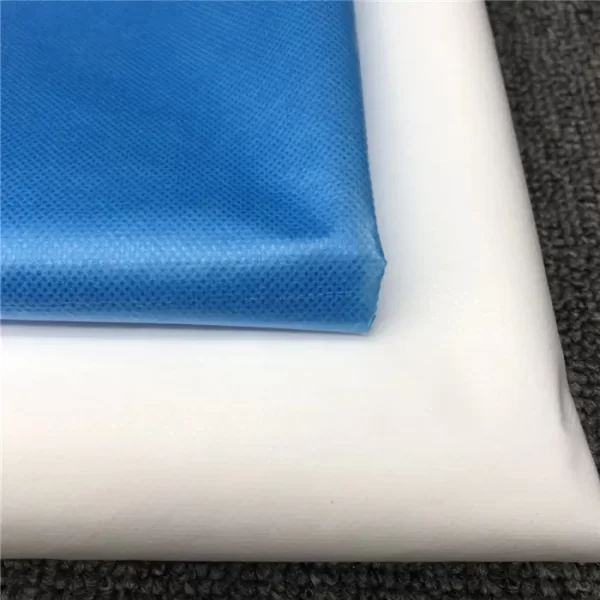A Revolutionary Textile: Laminated Nonwoven Fabrics
A marvel of modern textile engineering, laminated nonwoven fabrics, has been transforming multiple industries with their unique properties. Traditionally, textiles are produced by interlacing threads in a method known as weaving or knitting. However, nonwoven fabrics break this norm. They are composed of webs or sheets of fibers, bound together not by interlacing but through other mechanisms such as friction, adhesion, or cohesion.
The manufacturing process involves methods like spunbond, meltblown, needlepunch, and hydroentanglement, each producing fabrics with distinct characteristics. A subsequent step, known as lamination, is performed to further enhance the nonwoven fabrics. This process involves bonding layers together through heat and pressure. The end product retains the benefits of the original nonwoven fabric while incorporating the advantageous properties of the laminating material.
The resulting laminated nonwoven fabrics exhibit high tensile strength, superior stability, and excellent resistance against moisture, bacteria, abrasion, and UV radiation. These attributes have positioned these fabrics as a material of choice for a wide range of applications, particularly in the medical field.
Advantages of Laminated Nonwoven Fabrics in the Medical Field
When it comes to medical applications, any product or material introduced must meet strict requirements in terms of safety, hygiene, and performance. Laminated nonwoven fabrics have proven themselves to be a suitable candidate for this demanding environment due to their distinct properties:
1. Sterility and Hygiene
Sterility is a fundamental requirement in any medical setting to prevent infections and cross-contamination. Laminated nonwoven fabrics are able to withstand sterilization processes without losing their structure or properties. Furthermore, these fabrics exhibit an inherent resistance to bacteria, a vital feature for maintaining high standards of hygiene.
2. Barrier Properties
Lamination enhances the nonwoven fabric’s ability to serve as a robust barrier. This feature is essential to prevent the transmission of fluids, dust, and microbes, especially critical in healthcare settings to prevent the spread of infections.
3. Breathability and Comfort
Despite their superior barrier properties, laminated nonwoven fabrics do not compromise on comfort. These fabrics allow air and vapor to pass through, ensuring that they remain comfortable to wear, especially important when used for clothing, bedding, or wound dressings.
4. Customizability
One of the major advantages of laminated nonwoven fabrics is their versatility. Depending on the specific application, these fabrics can be engineered to exhibit various properties such as enhanced softness, UV protection, or fire resistance. This high degree of customizability is what makes laminated nonwoven fabrics particularly useful in the diverse field of medicine.
Significant Medical Applications of Laminated Nonwoven Fabrics
The versatility of laminated nonwoven fabrics has allowed them to carve out an indispensable place in numerous medical applications. Let’s explore some of the key areas where these materials are making a significant impact:
1. Protective Clothing and Accessories
In the healthcare sector, protective clothing and accessories are of utmost importance to ensure the safety of healthcare providers and patients. Laminated nonwoven fabrics, with their excellent barrier properties and comfort, have found widespread use in the manufacture of surgical gowns, lab coats, caps, and shoe covers.
2. Face Masks and Respirators
The global pandemic has catapulted the demand for face masks and respirators. Laminated nonwoven fabrics are perfectly suited for this application due to their ability to effectively filter out harmful particles while maintaining breathability.
3. Medical Packaging
Packaging in the medical field requires materials that can maintain sterility and protect the contents from environmental influences. Thanks to their strength, stability, and excellent barrier properties, laminated nonwoven fabrics are often chosen for packaging surgical instruments, medical kits, and pharmaceutical products.
4. Wound Care
The world of wound care has greatly benefited from laminated nonwoven fabrics. These materials can be engineered to be highly absorbent, non-adherent, and gentle on the skin. As such, they are used in the production of wound dressings, adhesive bandages, and surgical tapes.
5. Incontinence Products
The manufacturing of incontinence products such as adult diapers and bed pads requires materials that are high in absorbency and skin-friendly. Laminated nonwoven fabrics, with their ability to be customized to exhibit these properties, are a preferred choice for such applications.
The Future of Laminated Nonwoven Fabrics in the Medical Field
The role of laminated nonwoven fabrics in medicine is set to grow even more prominent with ongoing advancements in textile technology. Innovations are currently underway to develop fabrics with advanced properties. For instance, fabrics that demonstrate antimicrobial activity or improved barrier performance could greatly enhance healthcare outcomes. There is also a considerable push towards developing materials with enhanced biocompatibility to minimize adverse reactions when these materials come in contact with the body.
Emerging technologies are also paving the way for the development of smart nonwoven fabrics that are embedded with electronic components and sensors. These smart fabrics can interact with the user or the environment and have the potential to revolutionize patient monitoring and diagnosis.
Moreover, sustainability is now a significant focus in the textile industry. The development of biodegradable nonwoven fabrics could provide an environmentally friendly alternative to traditional fabrics without compromising on performance.
Conclusion
From maintaining hygiene in healthcare settings to enabling the development of comfortable protective clothing, laminated nonwoven fabrics play a pivotal role in the medical field. They offer a unique combination of properties that are tailor-made to meet the stringent demands of medical applications.
As we look to the future, we can expect these versatile materials to play an even more integral part in medicine, with continuous innovations expanding their potential. To stay updated with the latest developments in the use of laminated nonwoven fabrics in the medical field, consider subscribing to our newsletter and following us on social media. Together, we can keep a pulse on this exciting field, unlocking new possibilities and improving medical care in countless ways.
Please visit our website for more product details https://medposnonwoven.com/product-category/non-woven-fabrics/

